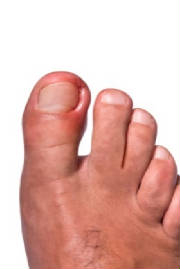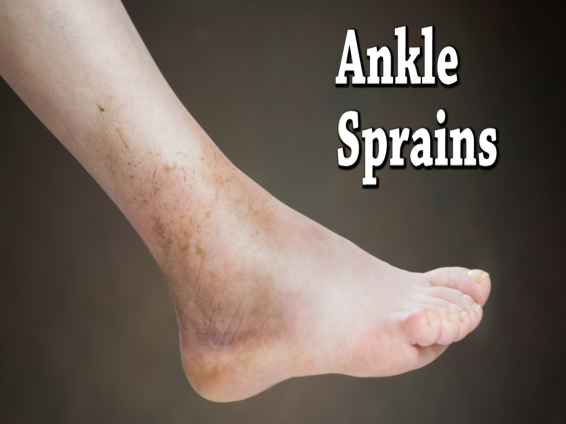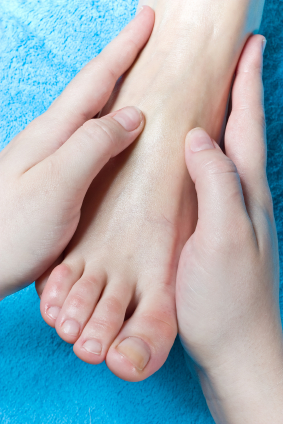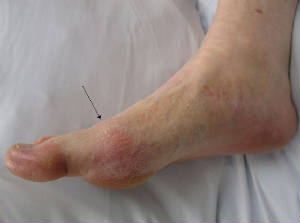|
Thursday, October 30, 2014
University of Nottingham Study Finds Ingrown Toenails Associated with Over Grooming A recent study conducted at the University of Nottingham found that trimming nails too often may actually lead to certain nail problems including ingrown toenails. After examining
how the nails stick to the nail bed and grow forward, researchers found that cutting the nails daily puts a certain force
on the nail that can make nails grow too slow or too fast as well as causing additional problems. A recent study conducted at the University of Nottingham found that trimming nails too often may actually lead to certain nail problems including ingrown toenails. After examining
how the nails stick to the nail bed and grow forward, researchers found that cutting the nails daily puts a certain force
on the nail that can make nails grow too slow or too fast as well as causing additional problems.
Lead study author, Cynthia Rauch, also used the research to find ways to avoid ingrown nail problems.
She states, “Looking at our results, we suggest that nail beauty fanatics who trim their nails on a daily basis opt
for straight or parabolic edges, as otherwise they may amplify the imbalance of stresses which could lead to a number of
serious conditions.” Ingrown toenails are terribly uncomfortable, and in the worst cases surgery might be required to get rid of them. If you think you have an
ingrown toenail, consult podiatrist Karin Johansson of New York. Dr. Johansson will confirm your diagnosis and do everything she can to treat your problem. Ingrown Toenails Causes Ingrown toenails occur
when a toenail grows sideways into the bed of the nail, causing pain, swelling, and possibly infection. There are a number of risk factors for ingrown toenails. Some include cutting your nails
too short, participating in strenuous sports, diabetes, obesity, and fungal infection. Some are genetically predisposed
to ingrown nails, although wearing ill-fitting or damp shoes can exacerbate the problem. Treatment There are a number of steps you can
take to treat ingrown nails: -Let your toenails grow out
-Soak
the toes in hot water with antibiotic soap or Epsom salts
-Placing a piece of cotton under the affected nail may
allow the toe to grow up instead of into the nail bed
-Rest with your feet up If however, your pain is severe, or you see red streaks running up your leg, you should see a podiatrist. Your podiatrist
may make a small incision and remove part of the toe nail to relieve the pressure. A local anesthetic may be used to lessen
the discomfort of the operation. Topical medication may also be prescribed to prevent the regrowth of the problem nail.
If you have any questions, feel free to contact our office in New York, NY. We offer the latest in diagnostic and treatment technologies to meet all your needs. Read more about Ingrown Toenails
Wednesday, October 22, 2014
Third Grader Bully Causes Broken Foot in Kindergartener
 Thaddeus Delaney, a kindergartener at Gust Elementary School, broke his foot during an incident with a Denver Public School bus. The five
year-old was in the process of giving his sister a hug when a third grader pushed him under the moving vehicle. Unable to
stop in time, the bus ran over his leg and foot, breaking three bones in his foot. Delaney was taken to the hospital in an
ambulance immediately after the event occurred. The Denver Police Department is still investigating the situation and the
elementary school is in the process of creating a bullying prevention plan. “He’s been mean to me all my life,”
Thaddeus said of the bully while sitting in a wheelchair with an orange cast on his leg. “There’s gotta be a
point where it’s gotta stop, it’s got to,” his mother added Thaddeus Delaney, a kindergartener at Gust Elementary School, broke his foot during an incident with a Denver Public School bus. The five
year-old was in the process of giving his sister a hug when a third grader pushed him under the moving vehicle. Unable to
stop in time, the bus ran over his leg and foot, breaking three bones in his foot. Delaney was taken to the hospital in an
ambulance immediately after the event occurred. The Denver Police Department is still investigating the situation and the
elementary school is in the process of creating a bullying prevention plan. “He’s been mean to me all my life,”
Thaddeus said of the bully while sitting in a wheelchair with an orange cast on his leg. “There’s gotta be a
point where it’s gotta stop, it’s got to,” his mother added
To prevent any future complications, a broken foot requires immediate medical attention and treatment. If you are seeking treatment for a broken foot, visit Dr. Karin Johansson of New York. Dr. Johansson will assess your injury and provide you with quality treatment. Broken Foot Causes, Symptoms, and Treatment
A broken foot is caused by one of the bones in the foot ‘breaking’, or fracturing. Bones typically break when
the bone is bent, crushed, or stretched beyond its natural capabilities. Usually the location of the fracture indicates
how the break occurred, whether it was through an object, fall, or any other type of injury.
Common Symptoms of Broken Feet: - Bruising
- Pain
- Redness
- Swelling
- Blue (foot)
- Numbness
- Cold
- Misshapen
- Cuts
- Deformities
Those who are experiencing any of these symptoms, or suspect that they have
a broken foot, should seek medical attention in a center where x-rays can be performed. This is especially urgent if
any of the symptoms include numbness, blue coloring, cold feet, cuts, misshapen toes or deformities as these indicate more
severe cases. Treatment for broken bones varies depending on the cause,
severity and location. Some will require the use of splints, casts or crutches while others could even involve surgery to
repair the broken bones. Personal care includes the use of ice and keeping the foot stabilized and elevated. If you have any questions, please feel free to contact our office in New York, NY. We offer the newest diagnostic and treatment technologies for all your foot and ankle needs.
Read more about Broken Feet
Wednesday, October 15, 2014
International Holiday Promotes the Benefits of Exercise October 8th is officially the International Walk to School Day. Hundreds of schools in Richmond Virginia had their students
on their feet in celebration of the day. International Walk to School Day provides the community with the chance to partake
in a global event that encourages exercise for all ages. October 8th is officially the International Walk to School Day. Hundreds of schools in Richmond Virginia had their students
on their feet in celebration of the day. International Walk to School Day provides the community with the chance to partake
in a global event that encourages exercise for all ages.
The event focuses on physical health and activity but
also educates students on the importance of pedestrian safety and safe walking routes. Linwood Holton Elementary, one of the
schools that participated in Walk to School Day, also hosted a Mini-Wellness Fair that will teach kids about healthy lifestyles.
All parents need to care for their children’s feet. If your child needs foot treatment, see podiatrist Dr.
Karin Johansson, DPM of New York. Dr. Johansson will care for your child’s foot needs.
How to Keep
Your Child’s Feet Healthy
Throughout childhood, it is very crucial for children to have and maintain
good health and proper care of their feet. With good foot health starting at an early age, foot problems and diseases can
be prevented in the future. As children continue to develop so do their feet, and require different techniques of care and
maintenance.
Even though babies do not begin walking until later stages, their feet should be taken care of properly:
- Stay away from socks that are too tight for your baby’s feet. This can cause pain
and allow less circulation
- Encourage your baby to move their feet as much as possible so they
feel comfortable with them
When your baby begins to learn how to walk, do not panic if
they are unsteady on their feet. Toddlers are just getting used to the way in which their feet work so wobbliness is completely
acceptable.
When your child grows out of their toddler years, here are a few steps they should take to stay with good
health within their feet:
- Practice proper hygiene with them
- Be observant of any injuries that might occur
For more information about Keeping
Children’s Feet Healthy, follow the link below.
If you have any questions, please contact our office located
in New York, NY. We offer the newest diagnostic and treatment technologies for all your foot care needs.
Read more
about Keeping Children’s Feet Healthy
Thursday, October 9, 2014
Arthritic Implant Acts as Shock Absorber Val Cornwall of Hillingdon, Middlesex received surgery for her arthritis of the big toe in 2011 and is extremely active today
compared to a few years ago. The success behind the sixty-seven year old’s surgery is a new putty implant known as Cartiva.
The implant was developed to ease the pain and stiffness associated with arthritis. The idea is that Cartiva, when inserted
between the bones of the toe, prevents the bones from rubbing together thus eliminating the discomfort. Britain has nearly
half a million citizens suffering from arthritis of the big toe and the flexibility and ability of this implant can act to
solve the arthritic problem. Val Cornwall of Hillingdon, Middlesex received surgery for her arthritis of the big toe in 2011 and is extremely active today
compared to a few years ago. The success behind the sixty-seven year old’s surgery is a new putty implant known as Cartiva.
The implant was developed to ease the pain and stiffness associated with arthritis. The idea is that Cartiva, when inserted
between the bones of the toe, prevents the bones from rubbing together thus eliminating the discomfort. Britain has nearly
half a million citizens suffering from arthritis of the big toe and the flexibility and ability of this implant can act to
solve the arthritic problem.
If left untreated, arthritis of the feet can be very problematic and could potentially
worsen. If painful arthritis has been troubling you, consult Dr. Karin Johansson of New York. Dr. Johansson will provide you
with quality foot and ankle treatment and alleviate your joint pain.
Arthritic Foot Care
In an average lifetime, we walk approximately 75,000 miles. This can put a great deal of stress on the 26 bones and 30 joints
that we have in our feet. As we get older, our feet lose flexibility and elasticity. Our shock absorbers weaken, and if arthritis
comes into play, the joints become inflamed and distorted. Arthritic foot care and treatment would become imperative at this
point.
It is best to take care of your feet by wearing well-fitted shoes. Certain conditions may develop when you
wear shoes that don’t fit properly, for example hammertoes, neuroma, and bunions. Wearing shoes that have a lower heel
and extra room in the shoe can help your feet be comfortable. In cases of rheumatoid arthritis, the arch in your foot may
become problematic. Buying shoes with arch support will help; it is also a good idea to buy shoes that contour to your foot.
Alleviating Arthritic Pain
-Specific exercises may help; stretching the Achilles tendon
can prevent further pain and injury. Stretching can also increase your mobility.
For more information about Arthritic
Foot Care, follow the link below.
If you have any questions, please contact our office in New York, NY. We offer
the newest diagnostic and treatment technologies for all your foot care needs.
Read more about Arthritic Foot Care
Thursday, October 2, 2014
FPH Reports Wage Growth and Gout are related  Reports from the Faculty of Public Health (FPH) report that gout, along with other Victorian-age diseases, have returned due to a combination of poor wage growth
and increased food prices. Poverty in Britain has been a topic of great debate since the global financial crisis began. Wages
have been below the rate of inflation since 2008. Reports from the Faculty of Public Health (FPH) report that gout, along with other Victorian-age diseases, have returned due to a combination of poor wage growth
and increased food prices. Poverty in Britain has been a topic of great debate since the global financial crisis began. Wages
have been below the rate of inflation since 2008.
John Middleton of the FPH states, “It is a condition we believe should have
died out. It’s getting worse because people can’t afford good quality food.” Gout considered a type of
arthritis that can be caused by obesity as well as a diet rich in chemical compounds called purines that are found in sardines
and liver. Gout can be prevented with healthy lifestyle choices and careful eating habits. If you are suffering from the effects of gout,
see podiatrist Dr. Karin Johansson of New York. Dr. Johansson will provide you with quality foot and ankle treatment. What is Gout? Gout is a type of arthritis caused by a buildup of uric
acid in the bloodstream. It often develops in the foot, especially the big toe area, although it can manifest in other parts
of the body as well. Gout can make walking and standing very painful and is especially common in diabetics and the obese. People typically get
gout because of a poor diet. Foods rich in purines like turkey, red meats, and liver can affect the body’s ability
to excrete uric acid, which in turn leads to hyperuricema, the blood condition that causes gout to develop. Genetic predisposition
is also a factor. The children of parents who have had gout frequently have as much as a one in five chance of developing
it themselves. Gout can easily be identified by redness and inflammation of the big toe and the surrounding areas of the foot.
Other symptoms include extreme fatigue, joint pain, and running high fevers. Sometimes corticosteroid drugs can be prescribed
to treat gout, but the best way to combat this disease is to get more exercise and eat a better diet. If you have any questions, please contact our office
located in New York, NY. We offer the newest diagnostic and treatment technologies for all your foot and ankle needs. Read more about Gout
|